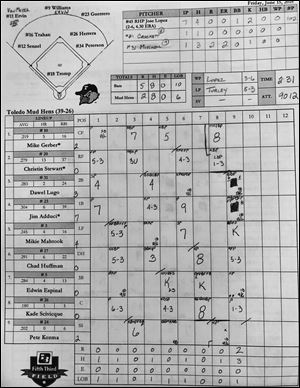
How to keep score at a baseball game
6/16/2018When it comes to keeping score, there are as many ways to keep score as there are people keeping score.

The completed scorecard of Mud Hens official scorer John Malkoski following Friday night's game between Toledo and the Louisville Bats. The scorecards provided to media at Hens' games are double-sided, with the Bats' at bats on the other side.
But there are a few basics that nearly every scorekeeper uses.
The first is the number system used to describe the different fielders, which comes in handy in describing how outs are recorded. Each of the nine positions is given a number, starting with 1 for the pitcher, 2 for the catcher, then around the infield from first base (3), to second (4), to third (5), before including the shortstop (6), then moving around the outfield from left (7), to center (8), to right (9).
So fly balls and popups are recorded by the player who catches it: a popup to shortstop can be recorded as a P6, while a fly caught by the center fielder can be written as F8 or simply 8. For groundouts, both players involved in the play are listed, so a groundout where the shortstop throws the batter out at first is recorded as 63.
As for strikeouts, the tradition is for scorekeepers to mark the out with a “K” — or a backward “K” for a called third strike. The tradition started with Henry Chadwick, a baseball scorekeeping pioneer who noted there were too many other possible meanings for a “S,” including stolen base, sacrifice, or sacrifice fly. Chadwick chose the “K” to represent a strikeout, and he also created the numbering system described above.
When a batter reaches base, scoring can get a little trickier. For a base hit, some scorekeepers use 1B for a single, 2B for a double, 3B for a triple, and HR for a home run; others use a line, with the number of lines equaling the number of bases for the hit.
From there, scorekeepers use a diamond to track the baserunners advance around the bases, marking either how the baserunner advanced or what following hitter pushed that runner around the bases. It is common for scorers to fill in the diamond of a player who scores a run, allowing for a quick tally of the current game score.
After that, every scorekeeper can develop his own particular style. Whether it is tracking pitches, marking the specifics for a baserunners journey around the bases, or marking fantastic plays, scorekeepers are invited to make their scoresheet a unique work of art.